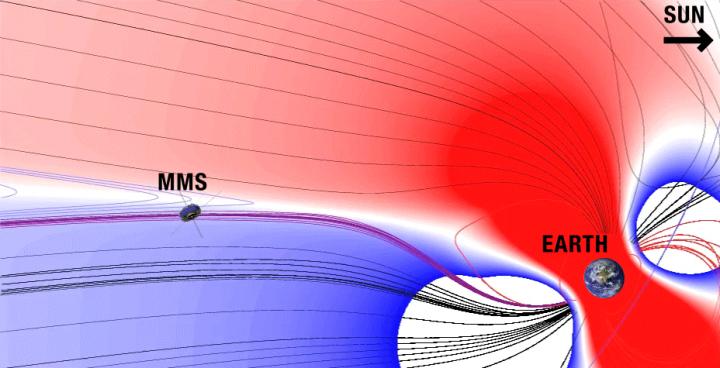NASA keeps watch over space explosions

In its second phase, NASA's Magnetospheric Multiscale Mission -- MMS -- is watching magnetic reconnection in action behind Earth, as shown here by the tangled blue and red magnetic field lines. View animated GIF: https://www.nasa.gov/sites/default/files/thumbnails/image/mms_wide.gif Credit: Patricia Reiff/NASA Goddard/Joy Ng
Some fly out into space, while others are funneled along magnetic field lines into Earth's upper atmosphere where they create auroras, or wreak havoc on power grids in the case of an extremely large event.
NASA's Magnetospheric Multiscale mission, or MMS, has been observing such explosions — created in a process called magnetic reconnection — for three years.
Recently, in the second phase of its mission, MMS saw reconnection in Earth's magnetotail — the part of Earth's magnetic environment trailing behind the planet, away from the Sun — with enough resolution to reveal its true nature more clearly. The results have been published in the journal Science.
Magnetic reconnection occurs around Earth every day due to magnetic field lines twisting and reconnecting. It happens in different ways in different places, with different effects. In the magnetotail, for example, the process can create aurora near Earth.
In the magnetotail the event watched by MMS was found to fling particles symmetrically, unlike how it does on the sunward side of Earth. Out front, the solar wind — a constant flow of charged particles from the Sun — pushes into Earth's magnetic field.
Because of their different densities, the two sides connecting are unequal, which causes magnetic reconnection to occur asymmetrically. On the backside, however, in the magnetotail, the explosion stems from an entanglement of two sets of — similarly intense — Earth field lines, so the particles are accelerated nearly the same in both directions.
Magnetic reconnection also happens on the Sun and across the universe — in all cases forcefully shooting out particles and driving much of the change we see in dynamic space environments — so learning about it around Earth also helps us understand reconnection in faraway places where it's impossible to measure directly.
The more we understand about different types of magnetic reconnection, the more we can piece together what such explosions might look like elsewhere, and how we can better prepare for extreme events here on Earth.
Media Contact
All latest news from the category: Physics and Astronomy
This area deals with the fundamental laws and building blocks of nature and how they interact, the properties and the behavior of matter, and research into space and time and their structures.
innovations-report provides in-depth reports and articles on subjects such as astrophysics, laser technologies, nuclear, quantum, particle and solid-state physics, nanotechnologies, planetary research and findings (Mars, Venus) and developments related to the Hubble Telescope.
Newest articles

A universal framework for spatial biology
SpatialData is a freely accessible tool to unify and integrate data from different omics technologies accounting for spatial information, which can provide holistic insights into health and disease. Biological processes…

How complex biological processes arise
A $20 million grant from the U.S. National Science Foundation (NSF) will support the establishment and operation of the National Synthesis Center for Emergence in the Molecular and Cellular Sciences (NCEMS) at…

Airborne single-photon lidar system achieves high-resolution 3D imaging
Compact, low-power system opens doors for photon-efficient drone and satellite-based environmental monitoring and mapping. Researchers have developed a compact and lightweight single-photon airborne lidar system that can acquire high-resolution 3D…





















